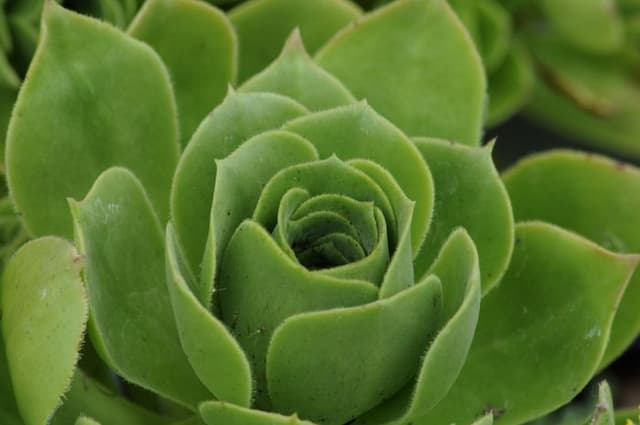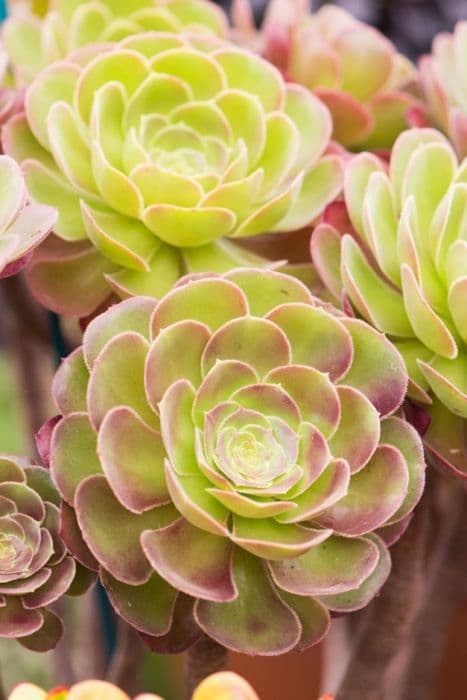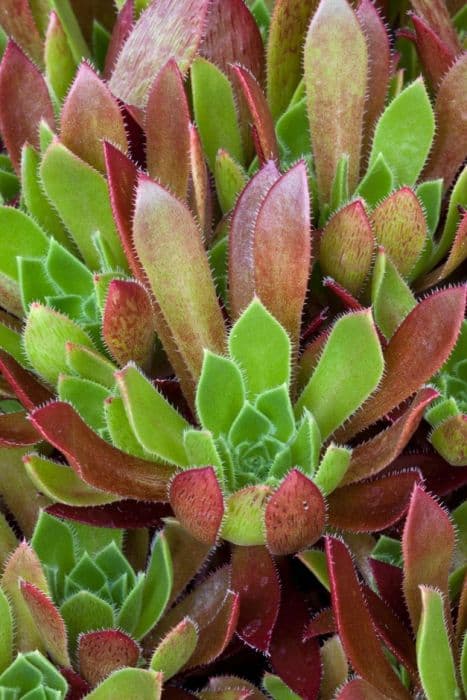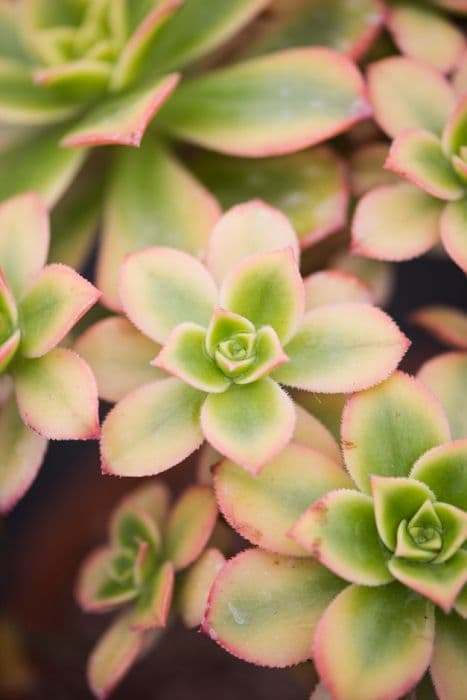Oregon stonecrop Sedum oreganum











ABOUT
Sedum oreganum, commonly known as Oregon stonecrop, is a succulent that boasts a striking appearance. The plant forms a mat-like structure with fleshy, evergreen leaves that are rich in color, commonly a deep green hue that may develop reddish tints, especially under stress conditions like drought or cold. Each leaf is small and rounded with a slight jellybean-like appearance. The foliage of Oregon stonecrop grows in a dense, rosette pattern, spiraling out from the center of the plant in a very orderly fashion, which gives it an attractive, symmetrical look. In warmer months, it sends up flowering stems that bear clusters of star-shaped blossoms. These flowers are typically a bright yellow, adding a lively contrast to the greenery. The blooms are a magnet for pollinators such as bees and butterflies, providing a small ecosystem service. This plant has a succulent nature, meaning its leaves and stems are thickened and engorged, which is an adaptation for storing water. Because of this, the plant has a juicy look and is quite tactile. The Oregon stonecrop’s structure allows it to withstand dry conditions and makes it an excellent choice for rock gardens, green roofs, or as groundcover in drought-prone regions. This resilience and the pleasing aesthetic make it a popular choice for gardeners and landscape designers looking for a tough yet attractive plant.
About this plant
 Names
NamesFamily
Crassulaceae
Synonyms
Oregon Stonecrop, Oregon Sedum
Common names
Sedum oreganum.
 Toxicity
ToxicityTo humans
Oregon stonecrop is generally considered non-toxic to humans. It is not known for containing poisonous substances that cause harm when touched or ingested. As with any plant, individual sensitivities or allergic reactions may occur, but there are no widespread reports of toxicity in humans associated with Oregon stonecrop.
To pets
Oregon stonecrop is also generally considered non-toxic to pets. It is not typically associated with poisoning in animals such as cats and dogs. However, ingestion of any non-food plant material can potentially cause gastrointestinal discomfort or an upset stomach in pets. Despite its general safety, it's a good practice to prevent pets from eating ornamental plants.
 Characteristics
CharacteristicsLife cycle
Perennials
Foliage type
Evergreen
Color of leaves
Green
Flower color
Yellow
Height
0.25 feet (7.62 cm)
Spread
0.50 feet (15.24 cm)
Plant type
Succulent
Hardiness zones
5
Native area
North America
Benefits
 General Benefits
General Benefits- Drought Resistance: Sedum oreganum, commonly known as Oregon stonecrop, is highly drought-resistant due to its succulent nature, making it suitable for xeriscaping and dry garden conditions.
- Low Maintenance: It requires minimal care once established and can thrive in poor soils with little watering or fertilization.
- Erosion Control: The plant's dense mat-forming habit helps stabilize soil and prevent erosion on slopes and in rockeries.
- Attracts Pollinators: Oregon stonecrop produces small star-shaped flowers that attract bees, butterflies, and other pollinators, supporting biodiversity.
- Edible Qualities: The leaves of Sedum oreganum are edible and can be consumed in small quantities in salads or as a cooked green (Note: Always exercise caution and verify the identification before consuming any wild plants).
- Aesthetic Appeal: With its fleshy green leaves and yellow to pinkish flowers, it adds visual interest to rock gardens, green roofs, borders, and containers.
- Ease of Propagation: It can be easily propagated from cuttings or leaves, making it simple to expand the garden or share with others.
- Seasonal Interest: This perennial plant offers year-round interest with its evergreen foliage and seasonal blooms typically in the summer.
- Hardiness: Sedum oreganum is hardy in a range of climates, often in USDA zones 4 through 9, tolerating cold temperatures once established.
- Ground Cover: It can serve as an effective ground cover, filling in spaces quickly and suppressing weeds with its spreading habit.
 Medical Properties
Medical PropertiesThis plant is not used for medical purposes.
 Air-purifying Qualities
Air-purifying QualitiesThis plant is not specifically known for air purifying qualities.
 Other Uses
Other Uses- Sedum oreganum, commonly known as Oregon stonecrop, can be used in green roofing systems to provide natural insulation and reduce stormwater runoff.
- The succulent leaves of Oregon stonecrop can be added to salads for a crisp, slightly bitter flavor, contributing a unique texture to culinary dishes.
- The plant can serve as a cover for ground-nesting bees, offering a protected habitat and promoting pollinator diversity in gardens.
- Oregon stonecrop can be infused into oils and used in candles for decorative purposes, where the oil imparts a subtle natural fragrance.
- The dense mats formed by this plant make it suitable for use in living walls or vertical gardens, creating a lush, verdant facade for urban buildings.
- Dried and crushed leaves of the Oregon stonecrop can be sprinkled onto soil to deter pests like slugs and snails without using chemical repellents.
- Oregon stonecrop can be used in rockeries and alpine gardens to mimic high-altitude landscapes, providing an aesthetic that complements stones and gravel.
- These plants can be planted along walkways and stepping stone paths, where they hold the soil in place and tolerate light foot traffic.
- The leaves of Oregon stonecrop produce a dye that can be used in small-scale natural fabric dyeing projects, yielding earthy green tones.
- Aquarists sometimes use sedum species like Oregon stonecrop in paludariums—semi-aquatic terrariums—to create a naturalistic background for amphibian habitats.
Interesting Facts
 Feng Shui
Feng ShuiOregon Stonecrop is not used in Feng Shui practice.
 Zodiac Sign Compitability
Zodiac Sign CompitabilityOregon Stonecrop is not used in astrology practice.
 Plant Symbolism
Plant Symbolism- Resilience and Adaptability - Oregon stonecrop thrives in harsh, rocky environments, symbolizing the ability to persevere and adapt to challenging conditions.
- Drought-tolerance - This plant can survive with minimal water, representing self-sufficiency and the capacity to endure dry spells in life.
- Longevity - Oregon stonecrop is known for its long life span, signifying enduring presence, persistence, and timelessness.
- Low-maintenance - The ease with which Oregon stonecrop grows suggests simplicity, effortless nurturing, and the beauty of independence.
- Healing - Historically, some Sedum species have been used for medicinal purposes, which can symbolize healing and recovery.
 Water
WaterOregon stonecrop should be watered sparingly, as it is a drought-tolerant succulent. Allow the soil to dry out completely between waterings to avoid root rot. In general, watering once every two weeks during the active growing season in spring and summer should suffice. During the winter, when the plant is dormant, reduce watering to once a month or less, depending on the humidity of your environment. Each watering should moisten the soil thoroughly, using approximately half a gallon for a medium-sized pot.
 Light
LightOregon stonecrop thrives in full sun to partial shade conditions. It prefers a spot that receives at least 6 hours of direct sunlight each day. If grown indoors, placing it near a south or west-facing window would provide the most ideal lighting conditions to keep the plant healthy and encourage vibrant foliage coloration.
 Temperature
TemperatureOregon stonecrop is a hardy plant that can tolerate a wide range of temperatures but thrives ideally between 65 and 75 degrees Fahrenheit. It can generally survive in temperatures as low as 20 degrees Fahrenheit, making it suitable for outdoor cultivation in many climates. Ensure that the plant is protected from extreme cold to prevent damage.
 Pruning
PruningPruning Oregon stonecrop helps maintain its shape, encourages growth, and removes any dead or damaged foliage. The best time to prune is in early spring, before new growth begins. Prune sparingly and selectively, removing only what's necessary to shape the plant or cut back any parts that are overgrown or unhealthy.
 Cleaning
CleaningAs needed
 Soil
SoilOregon Stonecrop prefers well-draining soil with a gritty composition, such as a mix of coarse sand, peat, and perlite or pumice. The best pH range for Oregon Stonecrop is between 6.0 and 7.5, aligning with its preference for slightly acidic to neutral soil conditions.
 Repotting
RepottingOregon Stonecrop should be repotted every 2-3 years or when it outgrows its container. This periodic repotting helps refresh the soil and provide room for growth.
 Humidity & Misting
Humidity & MistingOregon Stonecrop is tolerant of a wide range of humidity levels but prefers a drier environment, typical of its natural, rocky habitats.
 Suitable locations
Suitable locationsIndoor
Place Oregon Stonecrop in a sunny spot with good ventilation.
Outdoor
Plant in well-drained soil, full sun to partial shade.
Hardiness zone
4-9 USDA
 Life cycle
Life cycleOregon Stonecrop starts with seed germination, typically in early spring, triggered by warm temperatures and moisture. After germination, seedlings develop into young plants with a rosette of succulent leaves. These leaves photosynthesize and provide energy for growth and development. The plant then enters a vegetative stage, growing horizontally and forming a mat-like ground cover, which can also propagate vegetatively through leaf cuttings or offsets. In the following growing season or when mature, Oregon Stonecrop produces flowering stems with star-shaped yellow flowers, attracting pollinators for sexual reproduction. After pollination and fertilization, seeds are produced and dispersed, completing the life cycle.
 Propogation
PropogationPropogation time
Spring-Early Summer
The most popular method of propagating Oregon stonecrop, which is Sedum oreganum, is through leaf cuttings. During the active growing season, typically in spring or early summer, select a healthy leaf and gently twist it from the stem, ensuring that a small part of the stem is included. Let the leaf cutting dry for a couple of days until the cut end callouses over. After this, lay the cutting on well-draining soil, such as a mixture of potting soil and perlite or sand. Water sparingly, just enough to moisten the soil without making it soggy, as Oregon stonecrop is drought-tolerant and excessive moisture can cause rot. In a few weeks, the leaf will begin to develop roots and eventually new growth, at which point it can be transplanted if desired.









